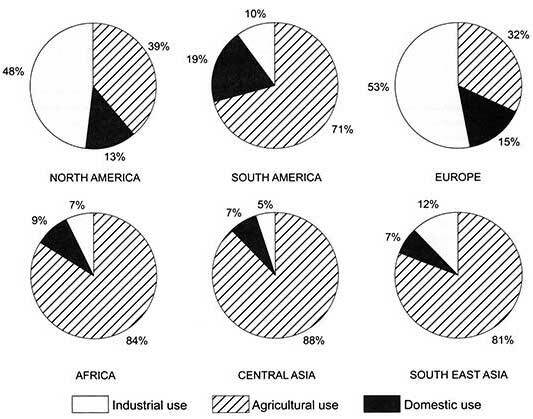Cam 10 Test 4 Writing Task 1
Summarise the information by selecting and reporting the main features and make comparisons where relevant.

Lược dịch bài mẫu
Các biểu đồ tròn cung cấp phân tích so sánh về mức sử dụng nước ở sáu khu vực trên thế giới, chia theo mục đích sử dụng trong công nghiệp, nông nghiệp, và sinh hoạt.
Nhìn chung, Châu Âu và Bắc Mỹ chủ yếu phân bổ nước cho các hoạt động công nghiệp, trong khi các khu vực còn lại ưu tiên nước cho nông nghiệp.
Tại Bắc Mỹ và Châu Âu, mô hình sử dụng nước cho thấy sự tập trung lớn vào các hoạt động công nghiệp, với khoảng một nửa lượng nước được sử dụng cho ngành này. Việc sử dụng nước cho nông nghiệp tại các khu vực này cũng đáng kể, chiếm 39% ở Bắc Mỹ và 32% ở Châu Âu. Ngược lại, chỉ có một tỷ lệ nhỏ được dành cho nhu cầu sinh hoạt, chiếm lần lượt 13% và 15% ở mỗi khu vực.
Tại các khu vực khác, nông nghiệp là ngành tiêu thụ nước chủ yếu. Chẳng hạn, Trung Á dành tới 88% nguồn nước cho nông nghiệp. Nam Mỹ dành gần một phần năm (19%) cho nhu cầu sinh hoạt, cao hơn đáng kể so với mức tiêu thụ nước sinh hoạt dưới 10% ở Trung Á, Châu Phi, và Đông Nam Á. Công nghiệp vẫn là ngành tiêu thụ ít nước ở hầu hết các khu vực này, ngoại trừ Đông Nam Á, nơi chiếm một phần khiêm tốn 12% tổng lượng nước sử dụng.
Bạn đang chuẩn bị cho kì thi IELTS?
Học IELTS Online qua ZOOM, bức band thần tốc
IELTS Thanh Loan – giáo viên 10 năm kinh nghiệm – trực tiếp đứng lớp, tự tin mang đến khóa học chất lượng nhất, phương pháp giảng dạy cô đọng dễ hiểu, giáo trình tự biên soạn cho lộ trình từ cơ bản đến luyện đề chuyên sâu. Đặc biệt, học viên luôn được quan tâm sát sao nhất, hỗ trợ không giới hạn, thúc đẩy kỷ luật học tập tốt để đạt mục tiêu.

Từ vựng hay
- Predominantly (adverb) /prɪˈdɑː.mɪ.nənt.li/
Nghĩa tiếng Việt: phần lớn, chủ yếu
Nghĩa tiếng Anh: mainly; for the most part. - Prioritize (verb) /praɪˈɔːrɪˌtaɪz/
Nghĩa tiếng Việt: ưu tiên
Nghĩa tiếng Anh: to arrange or deal with in order of importance. - Patterns (noun) /ˈpætərnz/
Nghĩa tiếng Việt: mô hình, khuôn mẫu, xu hướng
Nghĩa tiếng Anh: repeated or regular ways in which something happens or is done. - Comprise (verb) /kəmˈpraɪz/
Nghĩa tiếng Việt: bao gồm, gồm có
Nghĩa tiếng Anh: to include or contain; to consist of. - Dedicate (verb) /ˈdɛdɪˌkeɪt/
Nghĩa tiếng Việt: cống hiến, dành riêng
Nghĩa tiếng Anh: to devote time, effort, or resources to a particular purpose. - Striking (adjective) /ˈstraɪkɪŋ/
Nghĩa tiếng Việt: nổi bật, đáng chú ý
Nghĩa tiếng Anh: attracting attention by being remarkable or unusual. - Substantially (adverb) /səbˈstænʃəli/
Nghĩa tiếng Việt: đáng kể, một cách đáng kể
Nghĩa tiếng Anh: to a great or significant extent. - A minor consumer (noun phrase) /ə ˈmaɪnər kənˈsumər/
Nghĩa tiếng Việt: người tiêu dùng nhỏ/không đáng kể
Nghĩa tiếng Anh: a user or consumer that makes up a small portion of the total consumption. - Modest (adjective) /ˈmɑːdɪst/
Nghĩa tiếng Việt: vừa phải, khiêm tốn
Nghĩa tiếng Anh: relatively small or limited in amount, size, or degree
Xem thêm:
- Bài mẫu Writing Task 1 & 2 Cam 10 Test 1
- Bài mẫu Writing Task 1 & 2 Cam 10 Test 2
- Bài mẫu Writing Task 1 & 2 Cam 10 Test 3
- Bài mẫu Writing Task 1 & 2 Cam 10 Test 4
Đừng bỏ qua những cuốn sách cực hữu ích:
Cam 10 Test 4 Writing Task 2
Do you think the advantages of charging people for admission to museums outweigh the disadvantages?
Museums are both historical and educational centers that attract visitors of all ages. While some museums provide free entry, others require an admission fee. I believe that charging visitors offers more advantages than disadvantages.
On one hand, ticketed entry to museums could pose certain drawbacks. First, this policy may discourage students and low-income families from visiting, as they have other cost-free alternatives for learning about history, such as watching documentaries. This limited access might reduce public engagement with historical artifacts and weaken interest in national heritage. Moreover, as museums are typically state-funded with an educational purpose, charging entry fees could make them appear commercialized, diverging from their original mission.
However, I would argue that the advantages of entry fees outweigh these potential drawbacks. Primarily, charging admission provides funds to improve museum facilities, maintain exhibits, and employ additional staff, enhancing the overall visitor experience. This system also naturally filters visitors, attracting those genuinely interested in learning rather than those simply seeking entertainment, who might prefer to visit parks or malls. Lastly, entrance fees help alleviate the strain on public budgets. Without these fees, it would be impractical to expect free entry to a range of public facilities such as zoos, stadiums, and temples.
In conclusion, while museum entry fees may have some drawbacks, I believe they are outweighed by the benefits of improved facilities, focused visitor engagement, and reduced dependency on government funding.
Phân tích câu hỏi
Dạng câu hỏi: Discussion with opinion
Cấu trúc bài viết:
Introduction: Có hai nhiệm vụ cần được thực hiện ở phần Introduction, đó là:
Giới thiệu chủ đề:
- charge for admission = require/ ask visitors to pay entry fee = tickets are applied/ sold
- free = free of charge = without entrance fee
Đưa câu trả lời: Lợi của việc thu phí nhiều hơn so với hại
Body paragraph 1: Phát triển ý kiến mà mình không nghiêng về:
- Topic sentence: Khẳng định có một số mặt hại khi thu phí vào cửa bảo tàng
- Supporting idea 1: Khiến nhiều nhóm người như sinh viên hoặc người thu nhập thấp không thích đến bảo tàng nữa → học lịch sử qua một số cách miễn phí khác (xem phim tài liệu)
- Supporting idea 2: Làm mất giá trị của bảo tàng, không đơn thuần là nơi giáo dục lịch sử nữa mà còn có giá trị kinh doanh trong đó
Body paragraph 2: Giới thiệu ý kiến mình nghiêng về:
- Topic sentence: Thu phí vào bảo tàng có nhiều lợi hơn
- Supporting idea 1: Nâng cao chất lượng dịch vụ vì có tiền đầu tư vào các khía cạnh như nâng cấp hạ tầng, trang trí, an ninh …
- Supporting idea 2: Thanh lọc được những người đến bảo tàng, là để học về lịch sử chứ không phải vui chơi
- Supporting idea 3: Giảm gánh nặng cho ngân sách, vì nếu miễn phí vào bảo tàng → cũng phải miễn phí vào các địa điểm công cộng khác nữa.
Conclusion: Khẳng định lại câu trả lời
- Thu phí vào bảo tàng có một số điểm hại
- Nhưng nhiều điểm lợi hơn
Tự học IELTS tại nhà chỉ từ 1.2 triệu?
Bằng Khóa học IELTS Online dạng video bài giảng
Giải pháp tự học IELTS tại nhà, tiết kiệm chi phí, linh hoạt thời gian nhưng đảm bảo hiệu quả. Khóa học dạng video bài giảng có lộ trình học từng ngày chi tiết. Học viên học lý thuyết qua video bài giảng, thực hành Listening Reading trực tiếp trên website, còn Writing Speaking được chấm chữa trực tiếp bởi cô Thanh Loan. Mọi bài giảng đều có tài liệu học tập đi kèm.

Lược dịch bài mẫu
Các viện bảo tàng là những trung tâm lịch sử và giáo dục, thu hút khách tham quan ở mọi lứa tuổi. Trong khi một số bảo tàng miễn phí vé vào cửa, thì một số khác yêu cầu phí vào cửa. Tôi cho rằng việc thu phí vào cửa mang lại nhiều lợi ích hơn là bất lợi.
Một mặt, việc yêu cầu mua vé vào cửa bảo tàng có thể gây ra một số hạn chế nhất định. Trước hết, chính sách này có thể khiến học sinh và các gia đình có thu nhập thấp ngại đến tham quan, vì họ có những lựa chọn miễn phí khác để học hỏi về lịch sử, chẳng hạn như xem phim tài liệu. Việc tiếp cận bị hạn chế có thể làm giảm sự hứng thú của công chúng đối với các cổ vật lịch sử và làm suy yếu sự quan tâm đến di sản quốc gia. Hơn nữa, vì các viện bảo tàng thường được nhà nước tài trợ với mục đích giáo dục, việc thu phí vào cửa có thể khiến chúng bị nhìn nhận như các cơ sở thương mại, đi chệch khỏi sứ mệnh ban đầu.
Tuy nhiên, tôi cho rằng lợi ích của việc thu phí vào cửa lớn hơn những bất lợi tiềm ẩn này. Trước tiên, việc thu phí mang lại nguồn quỹ để cải thiện cơ sở vật chất của bảo tàng, duy trì các triển lãm và thuê thêm nhân viên, giúp nâng cao trải nghiệm cho khách tham quan. Hệ thống này cũng tự nhiên lọc ra những người đến tham quan vì mục đích học hỏi, thay vì những người chỉ muốn tìm kiếm nơi giải trí, những người có thể sẽ thích tham quan công viên hoặc trung tâm mua sắm hơn. Cuối cùng, phí vào cửa giúp giảm bớt áp lực cho ngân sách công. Nếu không có những khoản phí này, sẽ rất khó để mong đợi việc miễn phí vé cho một loạt các cơ sở công cộng như vườn thú, sân vận động, và đền chùa.
Tóm lại, mặc dù việc thu phí vào cửa bảo tàng có thể gây ra một số hạn chế, tôi tin rằng những lợi ích như nâng cấp cơ sở vật chất, thu hút đúng đối tượng khách tham quan, và giảm sự phụ thuộc vào ngân sách chính phủ đều là những điểm vượt trội hơn.
Từ vựng hay
- admission fee (noun) /ədˈmɪʃ.ən fiː/ – phí vào cửa
English meaning: the cost required to enter a place or event. - ticketed entry (noun) /ˈtɪk.ɪ.tɪd ˈɛn.tri/ – vé vào cửa
English meaning: admission requiring a purchased or reserved ticket. - cost-free alternatives (noun phrase) /kɒst friː ɔːlˈtɜː.nə.tɪvz/ – những lựa chọn không mất phí
English meaning: options that do not require payment. - documentaries (noun) /ˌdɒk.jəˈmen.tər.iz/ – phim tài liệu
English meaning: factual films or television programs that provide information on real events or people. - historical artifacts (noun phrase) /hɪˈstɒr.ɪ.kəl ˈɑː.tɪ.fækts/ – các hiện vật lịch sử
English meaning: objects from the past that hold historical significance. - national heritage (noun phrase) /ˈnæʃ.ən.əl ˈher.ɪ.tɪdʒ/ – di sản quốc gia
English meaning: the cultural, historical, and natural elements considered valuable to a country. - state-funded (adjective) /steɪt ˈfʌn.dɪd/ – được tài trợ bởi nhà nước
English meaning: financially supported by the government. - commercialized (adjective) /kəˈmɜː.ʃəl.aɪzd/ – được thương mại hóa
English meaning: made primarily for profit, often at the expense of authenticity. - diverge from (phrasal verb) /dɪˈvɜːdʒ frɒm/ – khác biệt, rẽ khỏi
English meaning: to move away from a path or standard. - genuinely (adverb) /ˈdʒen.ju.ɪn.li/ – thật sự, chân thật
English meaning: in a sincere or authentic manner. - exhibits (noun) /ɪɡˈzɪb.ɪts/ – vật trưng bày
English meaning: items displayed for public viewing, especially in museums or galleries. - alleviate (verb) /əˈliː.vi.eɪt/ – làm giảm bớt
English meaning: to make a problem or burden less severe.
Mời bạn cùng tham gia cộng đồng “Học IELTS 0đ” trên Zalo cùng IELTS Thanh Loan, nhận những video bài giảng, tài liệu, dự đoán đề thi IELTS miễn phí và cập nhật













